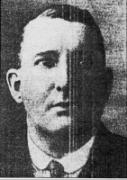|
|
||||||||||||||||||||||||
 |
Featured person
Recently added |
JSM Pringle (1909 - 1975): |
||||||||||||||||||||||
John Seton Michael Pringle was born on 12 July 1909 in Enniskillen, County Fermanagh, into the County Monaghan family which as well as prominent businessmen and land proprietors numbered among its members many well-known lawyers and medical men including the surgeon Seton Sydney Pringle, the physiologist Harold Pringle, the physician Brian Pringle, the High Court Judge Mr Justice Alfred Denis Pringle, and James A Pringle KC, MP; John was the youngest son of the last-named. He was educated at Castle Park Preparatory School, Dalkey, County Dublin (where his cousin Douglas Pringle was headmaster), and then at Haileybury College in Hertfordshire, and later as a scholarship student at Gonville and Caius College, Cambridge before entering the School of Physic in Trinity College Dublin in October 1930 with the degree of “BA ad eundem Cantab.”, that is, he was already of BA standing having studied and obtained the degree elsewhere (in Cambridge). At TCD he obtained the degrees of BAO, B.Ch. and MB in the summer of 1933 and the same year the MB, BChir of Cambridge. He then proceeded to obtain the Fellowship of the Royal College of Surgeons in Ireland (FRCSI) in 1935 and the Fellowship of the Royal College of Surgeons of London (FRCS) in 1937, the year he was appointed as Visiting Surgeon at Mercer’s Hospital, Dublin on the death of the popular James Owens.
Though now seemingly set for a successful career in Dublin (like his uncle, Sydney Seton Pringle, and other members of the extended family), in 1939 shortly after the outbreak of World War II he joined the Royal Army Medical Corps. He soon obtained the substantive rank of Major, and spent much of his time as a medical officer on board the liners Queen Mary and Queen Elizabeth which had been commandeered to serve as troopships to ferry servicemen mainly across the Atlantic. Later he was involved in the Normandy landings working with an advanced field surgical unit as early as D-Day +1, and which was later actively engaged during the Arnhem campaign, and when he finally resigned his commission in 1945 he held the acting rank of Lieutenant-Colonel. On return to Dublin he was appointed Visiting Surgeon to The Royal City of Dublin Hospital, Baggot Street in succession to his uncle, Sydney Seton Pringle, who had retired that year, and soon afterwards was appointed also to Drumcondra Hospital, The Rotunda Hospital, Stewart Hospital, and The Royal Hospital for Incurables, all in a charitable capacity.
Though a skilful and successful surgeon and with useful published case reports in the gastro-abdominal surgical field especially in the assessment of vagotomy for duodenal and anastomotic ulcers, Pringle lacked something of his uncle’s exuberant operative virtuosity. Teaching students and aspiring surgeons in their early years was more his forte and in 1952 he was appointed Professor of Surgery at the Royal College of Surgeons in Ireland, a post he held until 1961 when he was appointed Regius Professor of Surgery at Trinity College Dublin in succession to Adams Andrew McConnell (q.v.) and was in turn succeeded by Nigel Kinnear in 1967. Unfortunately he suffered minor, then debilitating strokes and, later, progressive blindness which were sore trials, and in 1972, after 27 years service, he had finally to resign his position as Visiting Surgeon at Baggot Street and give up most of his other professional commitments. He also had to abandon his lively recreational hobbies which, like those of many of his medical relatives, involved yachting and field pursuits: as an Appreciation in The Irish Times put it “Always a keen shot and yachtsman, he was never happier than when out with his dog in a bog or sailing his boat in Dublin Bay” (‘D’, 2nd June, 1975, p.11). Pringle was married twice; firstly in 1937 to Bunty Odlum (who died from poliomyelitis in 1950) leaving their three children: one son, Brian and two daughters, Mrs Clare Hamilton (who was MB, BCh, BAO of TCD in 1965), and Mrs Susan Credland: secondly, in 1959 to Nancy née Cornwall of Rathmore House, Naas, leaving her and his step-children Mr David Cornwall and Mrs Robert Woods.
| Born: | 12 July 1909 |
| Died: | 22 May 1975 |
| Peter Froggatt |
| Acknowledgements: Aisling Lockhart, Manuscripts & Archives Research Library at Trinity College Dublin, for advice on the ad eundem BA degree |
| Bibliography: Barry O’Donnell: Irish Surgeons and Surgery in the Twentieth Century (Dublin: Gill & MacMillan, 2008, p 171); JB Lyons: The Quality of Mercer’s, 1734-1991 (Dublin: Glendale Publishing Ltd,1991, pp 150, 152, 197); Ibid: An Assembly of Irish Surgeons (Dublin: Glendale Press, 1983 p 89); Davis Coakley: Baggot Street: A Short History of the Royal City of Dublin Hospital (Dublin: Board of Governors, RCDH, 1995, pp 118,123); Ibid: Medicine in Trinity College Dublin: An Illustrated History (Dublin: Trinity College, 2014, pp 240, 246); DA Webb (Compiler), JR Bartlett (Editor): Trinity College Dublin Record Volume 199 (Dublin: Trinity College Dublin Press, 1991, p 126); Obituaries: British Medical Journal, 21 June 1975, p.691; Lancet, 21 June 1975, p.1391; JSM Pringle: “Vagotomy: A preliminary report on fifteen cases”, Irish Journal of Medical Science, April 1949, pp 151-156 (No. 280). |


Home | Our Policies | Plaques | Browse | Search | Sponsors | Links | Help | Contact
Privacy & Disclaimer | Cookie Policy | Site Map | Website Design By K-Point
© 2024 Ulster History Circle









